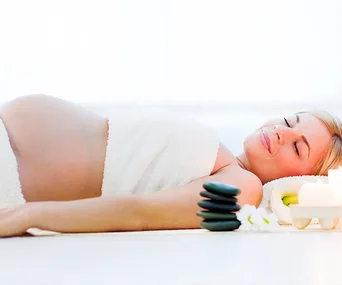Your body
At last, you should be getting over the morning sickness and general exhaustion of the past few months. Your bump isn’t yet big enough to get in the way of most things (except for certain sports) and you may feel much more energetic. If you’re lucky, you’ll start to feel even livelier than usual!
The mask
You’ve probably noticed that a dark line – the linea nigra – has appeared down the centre of your abdomen. You may also find that your skin colour becomes more pigmented: in particular, moles, birthmarks and freckles may darken. The skin on your face may darken, known as chloasma, or the ‘mask of pregnancy’. All these changes are normal and your skin will return to normal after birth. Wear sunblock to prevent the pigmentation becoming more pronounced.
Don’t eat your heart out…
There’s nothing romantic about heartburn, an unpleasant, burning sensation in your chest. It’s caused by over-enthusiastic pregnancy hormones making the valve at the top of your stomach relax, allowing stomach acid to pass back into the oesophagus – which hurts.
Help yourself by avoiding over-eating and not eating just before bedtime. Spicy and fatty foods can also trigger heartburn. You may find drinking a glass of milk just before going to bed helps to ease the discomfort; eating five or six small meals a day instead of three large ones can also help. Burnt out? Ask your pharmacist to recommend an antacid that’s safe during pregnancy.

Suffering heartburn? Avoiding spicy and fatty foods can also help.
(Credit: Getty Images)Your baby
Your baby is about 9cm long from crown to rump and weighs about 50g. She’s about the size of a tennis ball, but is still very scrawny, with no fat. Her skin is red and so transparent that bones and blood vessels can be seen through it. Her body and head are now covered with lanugo, a fine layer of downy hair.
Body-building
The bones that initially formed from soft cartilage are getting harder (ossifying) and retaining calcium, which makes them strong. If you were to have an x-ray (not advisable during pregnancy!), your baby’s perfectly formed skeleton would be visible. She’s flexing some of her muscles: she can grasp with her hands, squint and frown. She also starts to ‘look’ around beneath her closed eyelids, scanning to the right and left.
Great taste!
Your baby could start sucking her thumb: one of the earliest known reflexes, this may give her comfort for months (even years) after birth. She’s also making ‘rooting’ movements with her mouth, in preparation for latching on to your nipple when feeding after birth.

